Hatfield College, Durham
| Hatfield College | ||||||||||||||||||||||
|---|---|---|---|---|---|---|---|---|---|---|---|---|---|---|---|---|---|---|---|---|---|---|
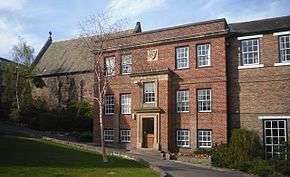 | ||||||||||||||||||||||
 | ||||||||||||||||||||||
|
| ||||||||||||||||||||||
| University | University of Durham | |||||||||||||||||||||
| Coordinates | 54°46′28″N 1°34′27″W / 54.7744°N 1.5741°WCoordinates: 54°46′28″N 1°34′27″W / 54.7744°N 1.5741°W | |||||||||||||||||||||
| Motto | Vel Primus Vel Cum Primis | |||||||||||||||||||||
| Motto in English | "Either the first or with the first" (colloquialised in College as "be the best you can be") | |||||||||||||||||||||
| Established | 1846 | |||||||||||||||||||||
| Named for | Thomas Hatfield | |||||||||||||||||||||
| Master | Tim Burt | |||||||||||||||||||||
| Undergraduates | 736 | |||||||||||||||||||||
| Postgraduates | 106 | |||||||||||||||||||||
| Senior tutor | Anthony Bash | |||||||||||||||||||||
| Website | ||||||||||||||||||||||
| Map | ||||||||||||||||||||||
 Location in Durham, England | ||||||||||||||||||||||
Hatfield College is a college of Durham University in England. Founded in 1846 by David Melville,[1] it was the second college to be associated with the university, after University College (founded 1832). The college was originally called Bishop Hatfield's Hall. It is named after Thomas Hatfield, Prince-Bishop of Durham from 1345 to 1381. The college's founder pioneered the idea of catered residences for students which would later evolve to the now common practice of student residences.
Hatfield College occupies a large site above the River Wear on North Bailey next to Durham Cathedral on the World Heritage Site peninsula. The buildings are an eclectic blend of 17th century halls, early Victorian buildings and major additions during the last century. The college's entrance is via a gateway from North Bailey. The college boathouse is situated within the grounds, as is the Victorian college chapel.
The current Master of the college is Tim Burt, Professor of Geography at Durham University, though he is set to retire in the summer of 2017.
History and buildings
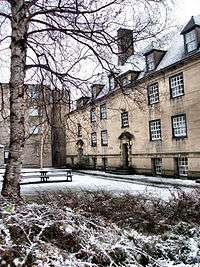
During the 18th century, the oldest part of the site was occupied by a coaching inn, the Red Lion, which was for many years the centre of concert and social life in Durham, hosting composers such as Charles Avison. The dining room, known in the 18th century as Richardson's Long-Room and later as Hoult's Assembly Room, remains substantially unchanged, retaining many of its original features.[2]
Hatfield College was established in 1846 as the second college of the University. The establishment of the college as a furnished and catered residence with fees set in advance was then a revolutionary idea, but later became general practice at student residences. This idea originated from the founding Master, David Melville, who believed that the poor should be able to afford college residence and higher education. Three principles of the model were that rooms would be furnished and let out to students with shared servants, meals would be provided and eaten in the college hall, and college battels (bills) were set in advance. Melville's model was not introduced in the university until recommended by the Royal Commission of 1862. It was later introduced at Keble College, Oxford and eventually worldwide.
Although not established as a theological college, in the first 50 years the majority of college members were theology students and staff. Senior staff members and the Principal (who was always a clergyman until 1897) were clerics. Student numbers rose to over 100, with the popularity of theology, and in the 1890s the college purchased Bailey House and the Rectory to accommodate its students. Towards 1900 the balance of students shifted from theology to education and science, and "C Stairs" were built to provide more accommodation.
The economic crisis of the 1920s led to uncertainty for Hatfield: it had more students than University College but lacked the facilities, especially kitchens, to accommodate them. To address this, the two colleges amalgamated, and all meals were taken together. Hatfield was awarded monies to fund its tutorial system and the introduction of electricity. During World War II the college was taken over by a local teaching college and students were moved to nearby accommodation on the Bailey. After the war and 20 years of co-operation with University College, Hatfield students could return to their college, although the college had problems such as the increased student numbers (a backlog of students resulting from the war) and rebuilding the morale and freedom of students. More buildings were constructed and refurbished (e.g. Pace, Gate-house and Kitchen Blocks) and accommodation was acquired away from the main site and the Senior Common Room was established.
In the late 20th century, student numbers increased again: living out became compulsory and many of the existing buildings were either rebuilt or refurbished to make room for students. Hatfield also became co-educational: the first female Senior Man held the post in 1992.
Chapel
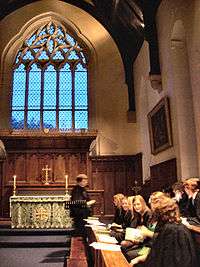
The college chapel was built in 1851, funded by donations by alumni and a loan from the university. The chapel was designed by the architect and then chaplain to Bishop Cosin's Hall, James Turner and contains two head sculptures of William Van Mildert and the Vice Chancellor and Warden Thorpe. Decorative furnishings were later added and the first organ was installed in 1882. Commemorative wooden panels marking the First World War dead and a book of remembrance for them, along with a lectern, were added gradually and were primarily funded by alumni and the Hatfield Association. The chapel houses a Harrison & Harrison organ, which is used to accompany services and for recitals, and was recently fully restored. Attendance at chapel services was compulsory for 80 years after the foundation of the chapel until the onset of World War II ended the compulsory attendance to Cathedral services.
The building now provides a setting for worship, quiet meditation and many other events in college life. Services are led by the college chaplain, currently Anthony Bash. The College Chapel Choir is led by a student choral director, supported by an organ scholar and deputy organ scholar. The Chapel Choir consists mainly of students who support regular worship in the chapel, but also sing at churches and cathedrals throughout the country and undertake annual tours both at home and abroad.[3]
Bar
The Hatfield Bar is popular with Hatfield Students, as well as students from other colleges who may be on Bailey Bar Crawls, due to its proximity to the centre of town. In the centre of the bar is a table known as the Session Table which was given to Hatfield by two American universities (Sewanee: The University of the South and Rhodes College) which hold close ties to Hatfield through a study abroad programme.
College traditions
Arms

The original arms used by the college consisted of the shield of Thomas Hatfield turned into a circular device with the motto “Vel Primus, Vel Cum Primis”. The use of these arms was, however, found to be illegal as they were not registered with the College of Arms.[4][5] As the arms had been used for over 100 years the college was able to use the shield, although it had to be differentiated from that of Hatfield by the addition of an ermine border around the shield.
The current coat of arms features the Shield of Hatfield and is blazoned as "Azure a Chevron Or between three Lions rampant Argent a Bordure Ermine", with the college motto underneath: "Vel Primus Vel cum Primis" which literally means "Either First or With the First"[6] although it is now misinterpreted by the college as "Be the Best you can Be".[7]
Academic dress
Similar to most Bailey Colleges the wearing of the undergraduate academic gown is required to formal events. The wearing of the gown is at the discretion of the Master of the college and at present is worn at Matriculation, in chapel and at formal meals held in the hall twice per week.
Grace
Benedicte Deus, qui pascis nos a iuventute nostra et praebes cibum omni carni, reple gaudio et laetitia corda nostra, ut nos, quod satis est habentes, abundemus in omne opus bonum. Per Jesum Christum, Dominum Nostrum, cui tecum et Spiritu Sancto, sit omnis honor, laus et imperium in saecula saeculorum. Amen.
This can be translated as: Blessed God, who feedest us from our youth, and providest food for all flesh, fill our hearts with joy and gladness, that we, having enough to satisfy us, may abound in every good work, through Jesus Christ our Lord, to whom with thee and the Holy Spirit, be all honour and praise and power for all ages. Amen.
The grace was widely used in the fourth century and is based on earlier Hebrew prayers. It was translated from the Greek and adopted by Oriel College, Oxford. Presumably influenced by Henry Jenkyns, who was a Fellow of Oriel, Hatfield adopted this grace practically verbatim. Since 1846 the grace has been read at all formal meals in College which occur once a week, or twice in Michaelmas Term.
Formals
Formals take place twice a week on a Tuesday and Friday in Michaelmas Term, reducing to Fridays only for the rest of the academic year. Hatfield Formal tickets are in high demand - both from Hatfielders and students from other colleges. There are a number of traditions at Formals. Students are required to wear their full academic dress including gowns for formal dinners except when it is a black or white tie event. A High Table consisting of members of the SCR and guests is present at every formal, the Master's entrance and "bowing out" signifying the official opening and closing of the formal meal. Students purchase a bottle of wine to take to formal purchased from the Bar. A speciality of Hatfield College is that students knock their spoons on the table at the beginning of the formal, before the food is served.
Common Rooms
The student body is divided into three "common rooms". The Junior Common Room (JCR) is for undergraduates in the college. The JCR annually elects an Executive Committee consisting of ten members including an impartial Chair. The Executive Committee ensures the successful running of the JCR, in conjunction with the College Officers. [8]
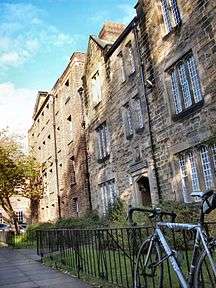
The current JCR Executive Committee members are:
| Position | Name |
|---|---|
| Senior Man | Harry Dow |
| Vice President (Discipline) | Emma Price |
| Welfare Officer | Laura Swinton |
| JCR Treasurer | Dominic Berry |
| Facilities Officer | Isaac Rudden |
| Communities Officer | Rory Flynn |
| Sports and Societies Officer | Joe Norbury |
| Social Secretary | Jadwiga Slomka |
| JCR Secretary | Chloe Sweetland |
| JCR Chair | Georgina Burford-Taylor |
The Middle Common Room (MCR) is the organisation for Postgraduate students which also have an elected organising committee. This is based at the college's postgraduate accommodation Palatine House.[9] College Officers, fellows and tutors are members of the Senior Common Room (SCR).[10] Each Common Room acts as a separate body for its members, although collaboration between them is common, and it is possible to be a member of these organisations simultaneously.
Sports and societies
Hatfield College Boat Club
| Hatfield College Boat Club | |
|---|---|
_Boat_Club_Blade.svg.png) | |
| Location | Hatfield College Boathouse |
| Home water | River Wear |
| Founded | 1846 |
| Affiliations | |
| Website |
www |
Hatfield College Boat Club (HCBC) is the boat club of Hatfield College at Durham University.
Other sports and societies
Hatfield College participates in most sports in the university. Hatfield has traditionally focused on rugby which has resulted in a host of alumni in the sports arena such as Andrew Strauss, Tim Curtis, Frank Tyson, Marcus Rose, Will Carling and Will Greenwood.[11] In addition, Hatfield has recently become known for excellence in hockey, football and basketball too. The college has an intense sporting rivalry with many of the other colleges on The Bailey, especially with nearby University College.
Hatfield College also has its own theatre group, the Lion Theatre Company, which performs in Durham University's Assembly Rooms theatre located opposite the college gates, and a music society organising various ensembles including an orchestra and a big band called "Kinky Jeff and the Hatfield Swingers". Students also produce the termly college magazine, The Hatfielder. Furthermore, it has SHAPED, which is a personal development program, aimed at increasing student's popularity with employers and at helping them develop academic skills. SHAPED also organises networking events, and is unique to Hatfield College [12].
Gallery
 View behind the tennis courts.
View behind the tennis courts. Bow Lane, which separates Hatfield College from St. Chad's College, and leads to Kingsgate Bridge.
Bow Lane, which separates Hatfield College from St. Chad's College, and leads to Kingsgate Bridge. Hatfield College Crest, without the accompanying helmet.
Hatfield College Crest, without the accompanying helmet. Entrance to the private car park on the back of Hatfield College.
Entrance to the private car park on the back of Hatfield College..jpg) Gate and Hatfield Crest seen from the North Bailey.
Gate and Hatfield Crest seen from the North Bailey.
College officers and fellows
Master
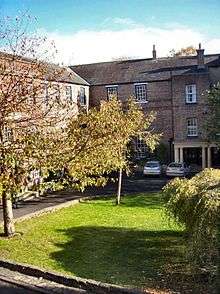
Tim Burt is the current Master of Hatfield College. He was appointed Dean of Colleges and Support Services between 2002–2006, leaving Angel Scott, an Acting-Master in his absence. He returned to his position as Master in 2006.
List of past Masters
- David Melville (1846–1851)
- William Henderson (1851–1852)
- Edward Bradby (Michaelmas Term 1852)
- James Lonsdale (1853–1854)
- John Pedder (1854–1859)
- James Barmby (1859–1876)
- William Sanday (1876–1883)
- Archibald Robertson (1883–1897)
- Frank Jevons (1896–1923)[13]
- Arthur Robinson (1923–1940)[14][15]
- Angus Macfarlane-Grieve (1940–1949) as acting Master[16]
- Eric Birley (1949–1956)[17]
- Thomas Whitworth (1957–1979)[18]
- James Barber (1980–1996)[19]
- Tim Burt (1996–present)
Fellows
College fellowships are awarded by the Hatfield College Council on the advice of the Master to alumni and people who have a close association with Hatfield; a fellowship is the highest honour that the college can bestow. On receipt of the fellowship the fellow automatically becomes an honorary member of the SCR and receives the same benefits such as the use of the SCR common and dining rooms as well as a brass plaque bearing the fellow's name being erected in the dining hall. As of 2007 the number of fellows stood at 18.
The first fellowships were awarded in 1991 to Kingsley Dunham, David Jenkins, Frederick Holliday, Gareth Roberts, Robert Allison, Bruce Oldfield and Sheila Armstrong. The former Master and pioneer of the college fellowship James Barber was awarded a fellowship in 1996. There is also a resident fellow, the current incumbent being T. A. Harman, who was granted the position in 2000.
Notable alumni
Hatfield alumni are active through organisations and events, such as the Hatfield association, which caters for the more than 7,500 living alumni.[20]
A number of Hatfield alumni have made significant contributions in the fields of government, law, science, academia, business, arts, journalism, and athletics, among others.
.jpg) Sir Tim Smit, founder of the Eden Project
Sir Tim Smit, founder of the Eden Project Jeremy Vine, presenter, broadcaster and journalist for the BBC
Jeremy Vine, presenter, broadcaster and journalist for the BBC
 Andrew Strauss, English international cricketer
Andrew Strauss, English international cricketer.jpg) The Lord Dannatt, retired senior British Army officer and former Constable of the Tower of London
The Lord Dannatt, retired senior British Army officer and former Constable of the Tower of London
| Name | Degree (Graduated) | Career | Ref |
|---|---|---|---|
| Cliff Addison | Professor of Inorganic Chemistry, University of Nottingham (1960–78), Dean of Faculty of Pure Science (1968–71), Leverhulme Emeritus Fellow, 1978 | [21] | |
| Gordon Black | BSc (1945) | Professor of Computation, Faculty of Technology, University of Manchester (1964–88) | [22] |
| John Boys | MA | Provincial Commissary to the Archbishop of Cape Town; Assistant Bishop of Southwark from 1968 | [23] |
| Warren Bradley | Manchester United F.C. and England footballer | [4][24] | |
| Simon Broadbent | BA | Visiting Fellow, National Institute of Economic and Social Research, since 1994 | |
| Robert Buckland | Law (1990) | Conservative Party Member of Parliament for Swindon South and HM Solicitor General for England & Wales | [25] |
| Gordon Cameron | BA | Professor of Land Economy, Cambridge University, and Master at Fitzwilliam College, Cambridge, from 1988 | [26] |
| Will Carling | BSc Psychology | Rugby union player for Harlequin F.C., former captain of the England national rugby union team (1988-1996) | [27] |
| Dominic Carman | Journalist and Liberal Democrat politician | [11] | |
| Patrick Carter, Baron Carter of Coles | Chairman, Sport England (2002–06) | [28] | |
| Andrew David Chambers | BA | Professor of Corporate Governance, London South Bank University, since 2004 | [29] |
| Tim Curtis | (1983) | England cricketer | [27] |
| Richard Dannatt, Baron Dannatt | BA Economic History (1976) | Former Chief of General Staff, British Army | [30][31] |
| Peter Dawes | BA | Bishop of Derby, 1988–95 | [32] |
| Kingsley Dunham | PhD (1932) | Geologist and mineralogist, Senior Fellow of Hatfield College (1990) | [33][34] |
| George Frost | BA (1956), MA (1961) | Archdeacon of Lichfield and Canon Treasurer of Lichfield Cathedral(1998–2000) | [35] |
| Frederick Goldie | BA (1938), MA (1946) | Bishop of Glasgow and Galloway (1974-1980) | [36] |
| Will Greenwood | BA Economics (1994) | England rugby union player and a member of the 2003 Rugby World Cup winning squad | [4][37] |
| Alastair Haggart | Bishop of Edinburgh in 1975-85 | [38] | |
| Temple Hamlyn | LTh 1889; Hon. MA 1902; DD 1904 | Bishop of Accra (1908 – 1910) | [39] |
| Clive Handford | BA, DipTh | Bishop in Cyprus and the Gulf (1996–2007), President Bishop, Episcopal Church in Jerusalem and the Middle East, 2002–07; an Assistant Bishop, Diocese of Ripon and Leeds, since 2007 | [40] |
| Ralph Hawkins | BA (1934) | Bishop of Bunbury from 1957 to 1977 | [41] |
| Sidney Holgate | BA Math (1940), DThPT (1941), MA (1943), PhD (1945) | Founder Master of Grey College, University of Durham, 1959–80 | [42] |
| Francis Johnston | BA | Bishop of Egypt (1952-1958) | [43] |
| William Kay | MA | Provost of Blackburn Cathedral, 1936–61 | [44] |
| Donald Knowles | BA Hons Theology | Bishop of Antigua (1953 – 1969) | [45] |
| Jeremy Campbell-Lamerton | Former Scottish rugby union lock | [4] | |
| Hugh McIntosh | BA (1942), MA (1945) | Provost of St Mary's Cathedral, Glasgow (1966 - 1970) | [46] |
| Harold Orton | BA (1921) | Professor of English Language and Medieval English Literature, University of Leeds (1946–64) | [47] |
| Mark Pougatch | BA Politics | Radio presenter, journalist and author | [48] |
| Arthur Robinson | BA (1891), MA (1894), Fellow (1895–99) BCL (1896), DCL (1900) | Master of Hatfield College | [15] |
| Louisa Reeve | British rower | [4] | |
| Marcus Rose | England rugby union international full back | [27] | |
| David Shukman | BA Geography | Environment & Science correspondent for BBC News | [11] |
| Tim Smit | Archaeology and anthropology | Businessman and archaeologist famous for his work on the Eden Project and the Lost Gardens of Heligan | [11] |
| Andrew Strauss | Economics (1998) | Former England Test cricket team captain | [49] |
| Jake Thackray | Musician | [11] | |
| Gordon Tindall | BA (1935) | Bishop of Grahamstown (1964 – 1969) | [50] |
| Frank Tyson | BA English Literature | England cricketer, later journalist and commentator | [27] |
| Jeremy Vine | BA English | Author, journalist and news presenter for the BBC | [11] |
| Dave Walder | Rugby union footballer who plays at fly-half for Mitsubishi Dynaboars in Japan | [4] | |
| Ben Woods | Former rugby union player who played for Newcastle Falcons and Leicester Tigers as an openside flanker | [4] | |
| Ted Wragg | BA German | Educationalist and academic, Professor of Education at the University of Exeter (1978-2003) | [11] |
References
- ↑ Dimbleby, Josceline Rose A Profound Secret Black Swan 2005 p33-35
- ↑ The Avison Ensemble website, URL accessed 10 July 2009
- ↑ Hatfield College Chapel Choir
- 1 2 3 4 5 6 7 Web site History of Hatfield
- ↑ Hatfield College : Crest and Motto - Durham University
- ↑ http://www.dur.ac.uk/resources/university.calendar/volumei/current/college.hatfield.pdf
- ↑ Hatfield College : College Life - Durham University
- ↑ Hatfield College JCR undergraduate student organisation, URL accessed 19 December 2009
- ↑ Hatfield College MCR postgraduate student organisation, URL accessed 19 December 2009
- ↑ Hatfield College SCR staff organisation, URL accessed 19 December 2009
- 1 2 3 4 5 6 7 List of alumni, dur.ac.uk, URL accessed May 18, 2009
- ↑ http://hatfield-shaped.com/
- ↑ ‘JEVONS, Frank Byron’, Who Was Who, A & C Black, an imprint of Bloomsbury Publishing plc, 1920–2008; online edn, Oxford University Press, Dec 2007 accessed 6 April 2013
- ↑ ‘MANLEY, Prof. Gordon’, Who Was Who, A & C Black, an imprint of Bloomsbury Publishing plc, 1920–2008; online edn, Oxford University Press, Dec 2012 ; online edn, Nov 2012 accessed 6 April 2013
- 1 2 ‘ROBINSON, Arthur’, Who Was Who, A & C Black, an imprint of Bloomsbury Publishing plc, 1920–2008; online edn, Oxford University Press, Dec 2012 ; online edn, Oct 2012 accessed 6 April 2013
- ↑ ‘MACFARLANE-GRIEVE, Lieut-Col Angus Alexander’, Who Was Who, A & C Black, an imprint of Bloomsbury Publishing plc, 1920–2008; online edn, Oxford University Press, Dec 2012 ; online edn, Nov 2012 accessed 6 April 2013
- ↑ ‘BIRLEY, Prof. Eric’, Who Was Who, A & C Black, an imprint of Bloomsbury Publishing plc, 1920–2008; online edn, Oxford University Press, Dec 2012 ; online edn, Nov 2012 accessed 6 April 2013
- ↑ ‘WHITWORTH, Thomas’, Who Was Who, A & C Black, an imprint of Bloomsbury Publishing plc, 1920–2008; online edn, Oxford University Press, Dec 2007 accessed 6 April 2013
- ↑ ‘BARBER, Prof. James Peden’, Who's Who 2013, A & C Black, an imprint of Bloomsbury Publishing plc, 2013; online edn, Oxford University Press, Dec 2012 ; online edn, Nov 2012 accessed 6 April 2013
- ↑ "The Durham Difference" (PDF). Durham University. Retrieved 2009-04-03.
- ↑ ‘ADDISON, Prof. Cyril Clifford’, Who Was Who, A & C Black, an imprint of Bloomsbury Publishing plc, 1920–2008; online edn, Oxford University Press, Dec 2012 ; online edn, Nov 2012 accessed 6 April 2013
- ↑ ‘BLACK, Prof. Gordon’, Who Was Who, A & C Black, an imprint of Bloomsbury Publishing plc, 1920–2008; online edn, Oxford University Press, Dec 2012 ; online edn, Nov 2012 accessed 6 April 2013
- ↑ ‘BOYS, Rt Rev. John’, Who Was Who, A & C Black, an imprint of Bloomsbury Publishing plc, 1920–2008; online edn, Oxford University Press, Dec 2012 ; online edn, Nov 2012 accessed 6 April 2013
- ↑ Obituary, manutd.com, URL accessed May 18, 2009
- ↑ "Members of Parliament for Swindon". Newsquest Media Group. Retrieved 12 March 2011.
- ↑ ‘CAMERON, Prof. Gordon Campbell’, Who Was Who, A & C Black, an imprint of Bloomsbury Publishing plc, 1920–2008; online edn, Oxford University Press, Dec 2012 ; online edn, Nov 2012 accessed 6 April 2013
- 1 2 3 4 Sporting history, dur.ac.uk, URL accessed May 18, 2009
- ↑ ‘CARTER OF COLES’, Who's Who 2013, A & C Black, an imprint of Bloomsbury Publishing plc, 2013; online edn, Oxford University Press, Dec 2012 ; online edn, Nov 2012 accessed 6 April 2013
- ↑ ‘CHAMBERS, Prof. Andrew David’, Who's Who 2013, A & C Black, an imprint of Bloomsbury Publishing plc, 2013; online edn, Oxford University Press, Dec 2012 ; online edn, Nov 2012 accessed 6 April 2013
- ↑ Sir Richard Dannatt profile, mod.uk, URL accessed May 18, 2009
- ↑ College fellows, URL accessed May 18, 2009
- ↑ ‘DAWES, Peter Spencer’, Who's Who 2013, A & C Black, an imprint of Bloomsbury Publishing plc, 2013; online edn, Oxford University Press, Dec 2012 ; online edn, Nov 2012 accessed 6 April 2013
- ↑ Obituary, Royal Society, URL accessed July 9, 2009
- ↑ ‘DUNHAM, Sir Kingsley (Charles)’, Who Was Who, A & C Black, an imprint of Bloomsbury Publishing plc, 1920–2008; online edn, Oxford University Press, Dec 2012 ; online edn, Nov 2012 accessed 6 April 2013
- ↑ ‘FROST, Ven. George’, Who's Who 2013, A & C Black, an imprint of Bloomsbury Publishing plc, 2013; online edn, Oxford University Press, Dec 2012 ; online edn, Nov 2012 accessed 6 April 2013
- ↑ ‘GOLDIE, Rt Rev. Frederick’, Who Was Who, A & C Black, an imprint of Bloomsbury Publishing plc, 1920–2008; online edn, Oxford University Press, Dec 2012 ; online edn, Nov 2012 accessed 6 April 2013
- ↑ Will Greenwood.co.uk, accessed May 18, 2009
- ↑ ‘HAGGART, Rt Rev. Alastair Iain Macdonald’, Who Was Who, A & C Black, an imprint of Bloomsbury Publishing plc, 1920–2008; online edn, Oxford University Press, Dec 2012 ; online edn, Nov 2012 accessed 6 April 2013
- ↑ ‘HAMLYN, Rt Rev. N. Temple’, Who Was Who, A & C Black, an imprint of Bloomsbury Publishing plc, 1920–2008; online edn, Oxford University Press, Dec 2007 accessed 6 April 2013
- ↑ ‘HANDFORD, Rt Rev. (George) Clive’, Who's Who 2013, A & C Black, an imprint of Bloomsbury Publishing plc, 2013; online edn, Oxford University Press, Dec 2012 ; online edn, Nov 2012 accessed 6 April 2013
- ↑ ‘HAWKINS, Rt. Rev Ralph Gordon’, Who Was Who, A & C Black, an imprint of Bloomsbury Publishing plc, 1920–2008; online edn, Oxford University Press, Dec 2012 ; online edn, Nov 2012 accessed 6 April 2013
- ↑ ‘HOLGATE, Dr Sidney’, Who Was Who, A & C Black, an imprint of Bloomsbury Publishing plc, 1920–2008; online edn, Oxford University Press, Dec 2012 ; online edn, Nov 2012 accessed 6 April 2013
- ↑ ‘JOHNSTON, Rt Rev. Francis Featherstonhaugh’, Who Was Who, A & C Black, an imprint of Bloomsbury Publishing plc, 1920–2008; online edn, Oxford University Press, Dec 2007 accessed 6 April 2013
- ↑ ‘KAY, Very Rev. William’, Who Was Who, A & C Black, an imprint of Bloomsbury Publishing plc, 1920–2008; online edn, Oxford University Press, Dec 2012 ; online edn, Nov 2012 accessed 6 April 2013
- ↑ ‘KNOWLES, Rt Rev. Donald Rowland’, Who Was Who, A & C Black, an imprint of Bloomsbury Publishing plc, 1920–2008; online edn, Oxford University Press, Dec 2012 ; online edn, Nov 2012 accessed 6 April 2013
- ↑ ‘McINTOSH, Rev. Canon Hugh’, Who Was Who, A & C Black, an imprint of Bloomsbury Publishing plc, 1920–2008; online edn, Oxford University Press, Dec 2012 ; online edn, Nov 2012 accessed 6 April 2013
- ↑ ‘ORTON, Prof. Harold’, Who Was Who, A & C Black, an imprint of Bloomsbury Publishing plc, 1920–2008; online edn, Oxford University Press, Dec 2012 ; online edn, Nov 2012 accessed 6 April 2013
- ↑ Interview, dur.ac.uk, URL accessed May 18, 2009
- ↑ Andrew Strauss profile at British Universities and Colleges Sport, URL accessed May 18, 2009
- ↑ ‘TINDALL, Rt Rev. Gordon Leslie’, Who Was Who, A & C Black, an imprint of Bloomsbury Publishing plc, 1920–2008; online edn, Oxford University Press, Dec 2012 ; online edn, Nov 2012 accessed 6 April 2013
Further reading
- T. A.Whitworth (1971). Yellow Sandstone and Mellow Brick. Hatfield.
- W.A. Moyes (1996). Hatfield 1846 – 1996. Hatfield Trust.
- W.A. Moyes (2004). Class of 1846. Hatfield Trust.
- Hatfield Students (1945–1947). The Hatfield Magazine. Hatfield.
- Hatfield Association (from 1947). The Hatfield Record. Check date values in:
|date=(help)
External links
- Hatfield College official website
- Hatfield College JCR undergraduate student organisation
- Hatfield College MCR postgraduate student organisation
- Hatfield College SCR staff organisation
- Hatfield History a brief interactive history of Hatfield College
- Hatfield College Boat Club (HCBC)
- Photos of Hatfield, collegiateway.org
